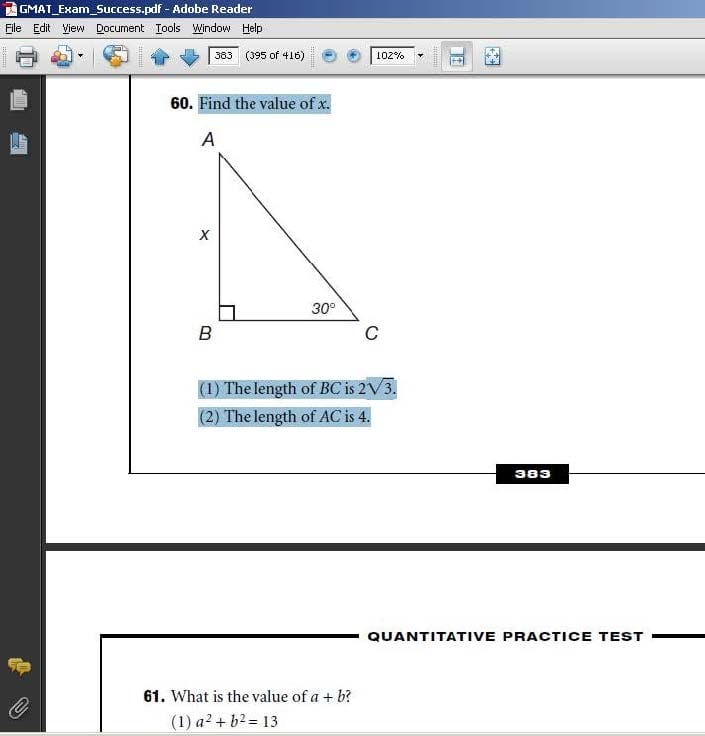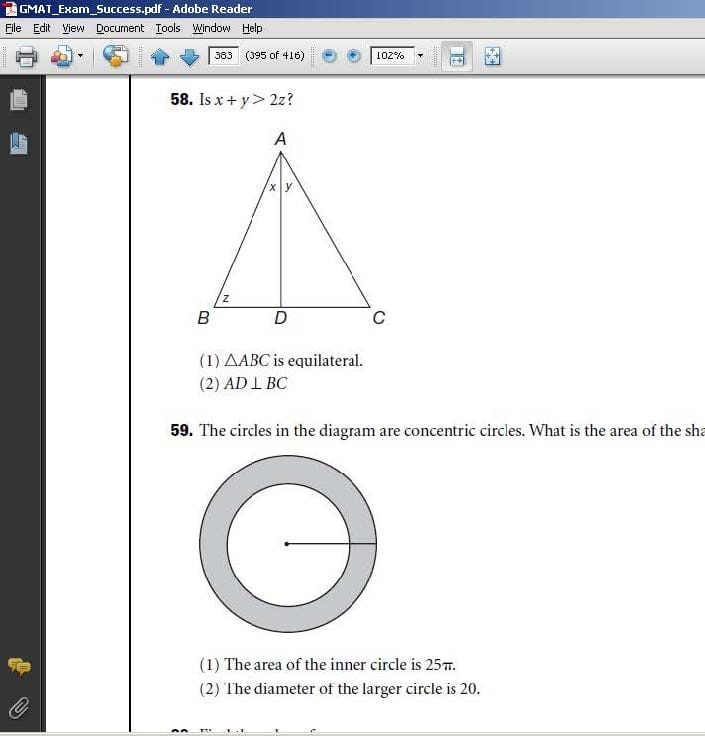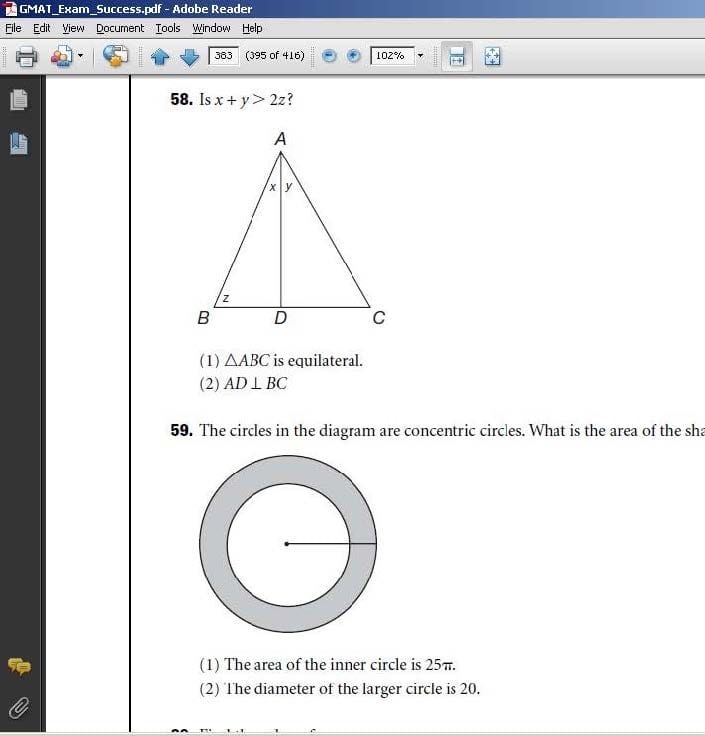Exam Details
Exam Code
:GMAT-QUANTITIVEExam Name
:GMAT - QuantitiveCertification
:Admission Tests CertificationsVendor
:Admission TestsTotal Questions
:738 Q&AsLast Updated
:Jul 01, 2025
Admission Tests Admission Tests Certifications GMAT-QUANTITIVE Questions & Answers
-
Question 251:
Two cars leave the same city traveling on the same road in the same direction. The second car leaves one hour after the first. How long will it take the second car to catch up with the first?
(1)
The second car is traveling 10 miles per hour faster than the first car.
(2)
The second car averages 60 miles per hour.
A.
Statement (1), BY ITSELF, will suffice to solve the problem, but NOT statement (2) by itself.
B.
Statement (2), BY ITSELF, will suffice to solve the problem, but NOT statement (1) by itself.
C.
The problem can be solved using statement (1) and statement (2) TOGETHER, but not ONLY statement (1) or statement (2).
D.
The problem can be solved using EITHER statement (1) only or statement (2) only.
E.
The problem CANNOT be solved using statement (1) and statement (2) TOGETHER.
-
Question 252:
What is the area of the circle?
(1)
The radius is 6.
(2)
The circumference is 12.
A.
Statement (1), BY ITSELF, will suffice to solve the problem, but NOT statement (2) by itself.
B.
Statement (2), BY ITSELF, will suffice to solve the problem, but NOT statement (1) by itself.
C.
The problem can be solved using statement (1) and statement (2) TOGETHER, but not ONLY statement (1) or statement (2).
D.
The problem can be solved using EITHER statement (1) only or statement (2) only.
E.
The problem CANNOT be solved using statement (1) and statement (2) TOGETHER.
-
Question 253:
What is the positive value of z?
(1)
3y + z = 4
(2)
z2 -z = 12
A.
Statement (1), BY ITSELF, will suffice to solve the problem, but NOT statement (2) by itself.
B.
Statement (2), BY ITSELF, will suffice to solve the problem, but NOT statement (1) by itself.
C.
The problem can be solved using statement (1) and statement (2) TOGETHER, but not ONLY statement (1) or statement (2).
D.
The problem can be solved using EITHER statement (1) only or statement (2) only.
E.
The problem CANNOT be solved using statement (1) and statement (2) TOGETHER.
-
Question 254:
Between what two numbers is the measure of the third side of the triangle?
(1)
The sum of the two known sides is 10.
(2)
The difference between the two known sides is 6.
A.
Statement (1), BY ITSELF, will suffice to solve the problem, but NOT statement (2) by itself.
B.
Statement (2), BY ITSELF, will suffice to solve the problem, but NOT statement (1) by itself.
C.
The problem can be solved using statement (1) and statement (2) TOGETHER, but not ONLY statement (1) or statement (2).
D.
The problem can be solved using EITHER statement (1) only or statement (2) only.
E.
The problem CANNOT be solved using statement (1) and statement (2) TOGETHER.
-
Question 255:

What is the value of a + b?
(1)
a2 + b2 = 13
(2)
2b =
A.
Statement (1), BY ITSELF, will suffice to solve the problem, but NOT statement (2) by itself.
B.
The problem can be solved using EITHER statement (1) only or statement (2) only.
C.
statement (1) or statement (2).
D.
The problem CANNOT be solved using statement (1) and statement (2) TOGETHER.
-
Question 256:
Find the value of x.

(1)
The length of BC is 2
.
(2)
The length of AC is 4.
A.
Statement (1), BY ITSELF, will suffice to solve the problem, but NOT statement (2) by itself.
B.
Statement (2), BY ITSELF, will suffice to solve the problem, but NOT statement (1) by itself.
C.
The problem can be solved using statement (1) and statement (2) TOGETHER, but not ONLY statement (1) or statement (2).
D.
The problem can be solved using EITHER statement (1) only or statement (2) only.
E.
The problem CANNOT be solved using statement (1) and statement (2) TOGETHER.
-
Question 257:
The circles in the diagram are concentric circles. What is the area of the shaded region?

(1)
The area of the inner circle is 25.
(2)
The diameter of the larger circle is 20.
A.
Statement (1), BY ITSELF, will suffice to solve the problem, but NOT statement (2) by itself.
B.
Statement (2), BY ITSELF, will suffice to solve the problem, but NOT statement (1) by itself.
C.
The problem can be solved using statement (1) and statement (2) TOGETHER, but not ONLY statement (1) or statement (2).
D.
The problem can be solved using EITHER statement (1) only or statement (2) only.
E.
The problem CANNOT be solved using statement (1) and statement (2) TOGETHER.
-
Question 258:
Is x + y > 2z ?

(1)
ABC is equilateral.
(2)
AD BC
A.
Statement (1), BY ITSELF, will suffice to solve the problem, but NOT statement (2) by itself.
B.
Statement (2), BY ITSELF, will suffice to solve the problem, but NOT statement (1) by itself.
C.
The problem can be solved using statement (1) and statement (2) TOGETHER, but not ONLY statement (1) or statement (2).
D.
The problem can be solved using EITHER statement (1) only or statement (2) only.
E.
The problem CANNOT be solved using statement (1) and statement (2) TOGETHER.
-
Question 259:
A rectangular courtyard with whole-number dimensions has an area of 60 square meters. Find the length of the courtyard.
(1)
The width is two more than twice the length.
(2)
The length of the diagonal of the courtyard is 13 meters.
A.
Statement (1), BY ITSELF, will suffice to solve the problem, but NOT statement (2) by itself.
B.
Statement (2), BY ITSELF, will suffice to solve the problem, but NOT statement (1) by itself.
C.
The problem can be solved using statement (1) and statement (2) TOGETHER, but not ONLY statement (1) or statement (2).
D.
The problem can be solved using EITHER statement (1) only or statement (2) only.
E.
The problem CANNOT be solved using statement (1) and statement (2) TOGETHER.
-
Question 260:
What is the numerical value of x2 -25?
(1)
x -5 = 3
(2)
4 -x = 5
A.
Statement (1), BY ITSELF, will suffice to solve the problem, but NOT statement (2) by itself.
B.
Statement (2), BY ITSELF, will suffice to solve the problem, but NOT statement (1) by itself.
C.
The problem can be solved using statement (1) and statement (2) TOGETHER, but not ONLY statement (1) or statement (2).
D.
The problem can be solved using EITHER statement (1) only or statement (2) only.
E.
The problem CANNOT be solved using statement (1) and statement (2) TOGETHER.
Related Exams:
Tips on How to Prepare for the Exams
Nowadays, the certification exams become more and more important and required by more and more enterprises when applying for a job. But how to prepare for the exam effectively? How to prepare for the exam in a short time with less efforts? How to get a ideal result and how to find the most reliable resources? Here on Vcedump.com, you will find all the answers. Vcedump.com provide not only Admission Tests exam questions, answers and explanations but also complete assistance on your exam preparation and certification application. If you are confused on your GMAT-QUANTITIVE exam preparations and Admission Tests certification application, do not hesitate to visit our Vcedump.com to find your solutions here.







